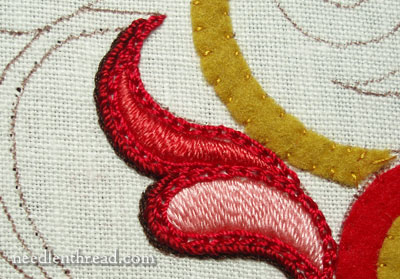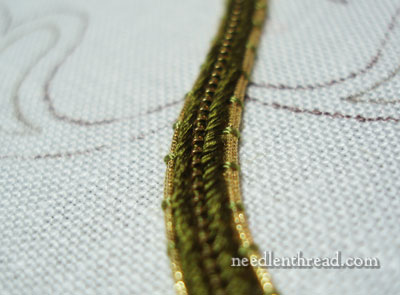Here’s a sneak peek at my current embroidery project! This from the beginning of the sample project. I’m working on a test piece, and when an element works out the way I want it to, I move over to the actual project, embroidering the element anew, with confidence that it’s exactly what I want… not just guesswork. This process makes for slow going towards any kind of definite finish, but it gives me a chance to work out several thread scenarios and make the threads do what I want them to do.

Earlier, I showed you some of the silk embroidery threads that I’m going to use in this project. They include quite an array of types of silk thread, all of which stitch up a little bit differently, and all of which look definitely different when stitched up. That, in a sense, is the point of the project – to explore how different silk threads behave, what they look like when used in different types of stitching, and how they combine with each other.
In the photo above, four types of silks are used in that small area: Soie d’Alger, which is a stranded spun silk (s-twisted, for those who are interested); Soie Perlee, which is a z-twisted heavier silk thread, Trebizond, which is a z-twisted even heavier silk thread, and Soie 100/3, which is a fine, strong z-twisted silk, a little heavier than a sewing thread.

You can always play with silk threads on their own, but it’s a lot more fun when you mix in some real metal threads, too. Here you see gold passing thread, couched in double lines on the outside of this small strip, coiled lizardine in the middle, stretched and wound with Soie de Paris, and a dark green Soie de Paris filling the inside of the strip.
Both of these elements developed into elements I like, so I’m now re-stitching them onto the “real” project, making only a few minor adjustments along the way.
While feeling my way through this project, I’ll share some shots of various elements with you, and then at some point, I’ll “unveil” the whole, so that you can see where I’m going. While catching glimpses of the individual elements, try to imagine what the whole looks like! I’d be interested to see if the finish is anything like what you expect. There’s a part of me that thinks this whole thing may end up being a true “jumble” – a mess, in short! But if I can reproduce on fabric, with needle and thread, the idea that I have in my head (and sketched out generally on paper), then maybe it won’t be as bad as that other part of me is predicting!
Well, we can but see!
Vacation, by the way, is officially over, so next week, back to the grind! Less time for needlework and for my ongoing (never ending, mammoth) Organizing Project, but still, it plans to be an interesting next several months!







Dear Mary, It sure looks like another winner, So far it is definitely intriguingly beautiful. Can’t wait to see the rest of it.
Lots of love Elza. Cape town.
That’s the difficult part, trying to imagine what the colors and textures will look like on the fabric. I’m so color challenged that it’s a very hard thing for me to do. Do you ever try out the color choices on the computer? Scan in the design and fill in the colors so you get a feel for the overall mix and balance? Stitching areas twice takes a lot of your time and threads. Just wondering if a computer mock up would help.
I think your work on ths piece is going to be very elegant by the look of it. Can’t wait to see the end product.
I have a question for you, do you generally pad your stitches when using those beautiful silk threads or just satin stitches?
Mary! Looks beautiful as usual! I particularly like the second shot! Love those greens and gold.
2011 promises a lot of new and beautiful embroideries!
Thank you Mary for sharing this exceptional blog.
It looks fascinating! You are such a tease!!
I like how you’re combining the different types of silk threads!
Hi, All – Thanks for your comments!
Hi, Irene – I actually do have a “mock up” – but it is done on paper, with watercolors and color pencils… and then I have an overlay of “other things” I might do with it. It’s not really a question of color combination, as much as a question of the stitches working the way I want them to, with the thread I want to use, and looking right, and that’s something that is best figured by trial-and-error, by actually stitching (at least for me, anyway!).
Mary Jane – I pad the goldwork areas, and the satin stitches. The goldwork areas are padded with felt, and satin stitch is simply padded satin stitch (with a split stitch outline, and filled first with stitches worked perpendicular to the stop layer of satin stitching).
Thanks again for your comments!
~MC
Hi Mary, if these first two motifs are anything to go by, it is going to look wonderful. While it has a strong Jacobean feel to it, it also reminds me of paisley. Not the shape but the way the motifs are filled with rows of different colours and patterns.
So far I like it a lot 🙂
Looks very interesting so far.
Trial runs – good idea.
That edging with the lizardine is *just gorgeous* !
“to explore how different silk threads behave, what they look like when used in different types of stitching, and how they combine with each other. “…….I hope that you talk about this lots.
Thistle threads was offering a whole on-line course studying the different appearance of silk threads and I was dying to do it to find out just such information – but it is a counted work piece, and I’m no good at counted work. So I’d love to heard about not just the differences between different threads, but the differences between the different applications/laying of the same thread in different situations. (I hope you follow me)
goodness. genius talent. stitching since childhood plays a part, sure, but you’re gifted, c’mon. like others, i’m wincing over the time/cost/thread of your practice runs…but a piece that turns out wrong is also time/cost/thread, right? wonder if i could readjust my head that way…i dunno…especially with goldwork! God bless Mary Corbet!